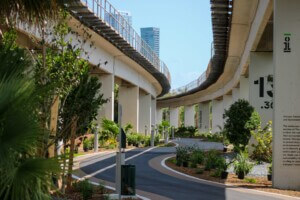“When I bought my house in 1995, this was never an issue…and it’s progressively gotten more and more and more with different years being different levels of flooding,” explained Key Largo resident Emily Stewart at a June 2021 special meeting of Florida’s Monroe County Board of County Commissioners. Stewart spoke out at the meeting to express her frustration over 90 consecutive days of flooding in 2019 and 70 consecutive days in 2020, due to seasonal “king tides,” which are increasing because of climate change. Stewart asked the commissioners to act quickly to address the issue, specifically requesting roadway and infrastructural improvements.
Impacts like flooding are making the climate crisis very real for Floridians, like those in Monroe County, a largely rural area on the southern tip of the state that includes the Florida Keys. Back in 1974, much of the county was designated an Area of Critical State Concern by the Florida Legislature, which recognized the diversity of resources of statewide significance and called for a land management system to aid in the area’s protection. Since then, it has seen repeated damage from natural disasters, including 2017’s Hurricane Irma, and remains highly vulnerable to sea level rise and extreme weather events.
Florida’s flatness, abundant coastline, and frequency of tropical storms, paired with continued development in at-risk areas, make the state extremely prone to flooding. According to research from First Street Foundation, 4.3 million residential properties in the United States face
“substantial flood risk,” and 1 million of them are in Florida. The vulnerability of these properties translates into the highest concentration of expected economic damage in any state, totaling $8 billion in potential annual losses.
Voluntary buyout programs are one option for homeowners looking for a way out and can ultimately be less expensive for the federal government than repeated flood insurance payouts through the Federal Emergency Management Agency’s National Flood Insurance Program. Monroe County oversees multiple buyout programs, including the Rebuild Florida Voluntary Home Buyout Program, created in 2019 in response to Irma with federal community development block grants allocated to disaster recovery. Out of the $44 million in Rebuild Florida funding made available to 11 local governments, Monroe County received $15 million. Prioritizing low-to-moderate-income areas, the county uses the money to purchase properties at market value, then demolishes existing improvements and adapts the land for public use, such as stormwater infrastructure, recreation, or open space.
In early December 2021, Monroe County extended the registration deadline for the buyout program until further notice. When the county submitted its application for Rebuild Florida grant monies in 2019, it identified a pool of 60 potential applicants. However, an extended administrative process, the sale of properties on the open market, and other factors caused that number to dramatically decrease. The Monroe County Land Authority (MCLA) reports the program now has around 20 applicants, with most located in the Big Pine area. The applicants’ properties are dispersed, which inherently limits the public uses possible with aggregated properties, but it’s a challenge the MCLA is prepared for. Since its creation in 1988, it has acquired or assisted in the acquisition of over 4,600 parcels, including 112 parcels totaling over 100 acres in 2020 alone.
Despite government action to reduce risk and damage, the real estate and development community’s response to risk assessments and climate change data remains mixed. According to law firm Berger Singerman’s 2019 South Florida Real Estate Survey, only 35 percent of South Florida real estate professionals felt climate change was the most pressing issue the market faced, and 58 percent indicated that climate change would have zero impact on how they planned or developed. In the 2020 survey, climate change slipped even further in relevance, losing out to concerns about remote working and migration induced by the COVID-19 pandemic. The focus on such factors isn’t unwarranted. For those living and building in high-risk areas, the inability to secure mortgages or insurance will inevitably have more impact than climate change projections.
For my colleague Jeffrey Carney, who directs the Florida Institute for Built Environment Resilience at the University of Florida, buyout programs pose broader questions about resilience and how to holistically address community challenges. As buyouts reduce density and the resident population, a community is left with a decreased tax base, maintenance challenges, gaps in the physical fabric, and costly adaptation of utility and transportation infrastructure. He also notes that a focus on mitigation or efforts to lessen the impacts distracts us from addressing the root causes of climate change. Carney goes on to explain that communities need coherent, multipronged approaches to address climate change, with buyout programs being one available tool. For Monroe County and other Florida communities administering them, Carney points to the need for adjusted development patterns and the use of complementary tools to deter new construction in at-risk areas: “What is the net benefit if you remove four houses from a community and a developer goes and adds six new ones?”
Sarah Gamble is an assistant professor at the University of Florida School of Architecture.











